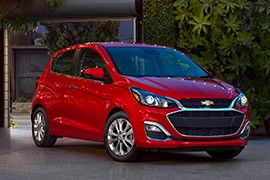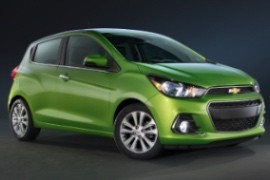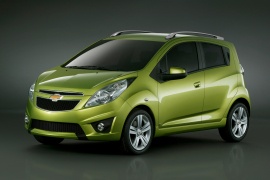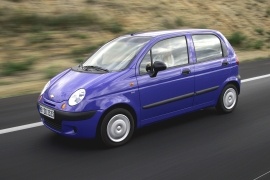CHEVROLET Matiz / Spark Models/Series Timeline, Specifications & Photos
First production year: 2000
Engines: Gasoline, Diesel
Body style: Hatchback
If there would be a contest for the best pizza-delivery car, the Spark could take the crown thanks to its low purchase price combined with great fuel efficiency.
GM kept the old platform from Daewoo and used it over and over again for the Spark. Chevrolet introduced the fourth generation of the small vehicle in 2015 and, three years later, it received a mid-cycle refresh that brought new interior features and improved exterior styling.
GM design department didn't have to go too far in improving the Spark. The grille was changed with a more prominent "mouth" in the lower bumper area and featured a chromed surrounding for both. An LED daytime running light system was enclosed in the headlights. In the rear, the taillights remained virtually unchanged.
Inside, Chevrolet introduced a standard infotainment system that supported Apple CarPlay and Android Auto, plus access to MyChevrolet mobile app. Its 7" touch-screen sat on top of the center stack. GM granted the U.S. customers a limited trial for the OnStar system. The dashboard didn't look like a budget-car one. Its instrument cluster featured a center-mounted speedometer with a tachometer on the left and an LCD on the right. At the far left, a small digital line showed the fuel level. If the steering wheel buttons were something special in the '90s, the 2018 Spark had them fitted as standard.
In the U.S. It is offered with a 1.4-liter gasoline engine, with a claimed fuel consumption of 3.9 l/100 km (40 mpg.). It came standard with a 5-speed manual transmission, and a CVT was available as an option.
The fourth generation of the Chevrolet Spark was launched in 2015 at the New York Auto Show, and it was designed for those who needed an affordable transportation vehicle or for delivery companies.
After GM bought the remaining parts of the Daewoo Motor Corporation, it also took some of the platforms the Korean automaker had already developed. One of them was made for the Daewoo Matiz, which quickly became the Chevrolet Spark in Europe. That version was not sold in the U.S., but the idea of a globally affordable car sparked the imagination of GM’s executives from those times. As a result, GM continued producing the Spark and transferred it to the U.S., although with significant improvements in terms of safety and technology.
Unlike the original Spark/Matiz, the fourth generation of this nameplate didn’t share the same egg shape; it looked like a small-sized hatchback. The front fascia sported big, corner-mounted headlights that flanked a narrow upper grille where the bow-tie badge took center stage. On the lower bumper, the automaker installed an oversized grille crossed by a fat horizontal slat for the license plate. Depending on the options, customers could get the vehicle with fog lamps mounted on the outer sides of the apron.
From its profile, the 2016 Spark revealed an ascending waistline adorned by a chromed stripe on the lower side of the windows’ line. The sculptured doors revealed other ascending lines towards the back of the vehicle, while the rear quarter panels sported flared wheel arches. The rear doors’ handles were neatly concealed into the C-pillars by black trims mounted on the doors. Finally, at the back, the almost vertical tailgate adorned by a roof spoiler that included the third brake light was flanked by L-shaped taillights.
The interior was surprisingly spacious for its segment, featuring high-mounted seats for the driver and their side passenger, while in the back, the narrow bench seat was just enough for two adults. Another unusual feature available for the 2016 Spark was the 7” touchscreen that sat atop the center stack for the infotainment system that featured Apple CarPlay and Android Auto. Inside the small instrument cluster, GM placed the speedometer in the middle, flanked on its left by the tachometer and on the right by a TFT display that showed various data from the car’s onboard computer. The silver plastic trims spread around the cabin tried to enhance the look of the vehicle.
Under the hood, GM installed a 1.4-liter naturally-aspirated gasoline engine paired with a five-speed manual or a CVT that sent the power to the front wheels. The Spark’s independent front suspension and rear torsion beam were suitable for the urban environment, providing comfortable and safe rides for its occupants.
Following the acquisition of the Daewoo brand, General Motors decided to keep on building the vehicles that made the Korean brand successful on the European market and the Matiz was the first option.
The Daewoo Matiz was built in 1998 by Daewoo in Europe after a design signed by Giorgetto Giugiaro. Its low price and the decent interior were highly appreciated and the car was received well by the growing countries in Eastern Europe. The car was constantly updated by Daewoo until the Korean car-maker was bought by General Motors. The new owner launched an updated version of the Matiz, named Spark. The second generation of the Spark was introduced in 2009 with a new look based on a new platform.
The design was bold for the small-segment. It featured enlarged fenders over the wheels, creating an image of a larger car. The big headlights and the high greenhouse created a crossover image. It was larger than its predecessor and offered a much roomier interior.
Inside, the most attractive part was the instrument panel, which featured a motorcycle-like layout with a round speedometer and an LCD attached on the right, on a pod. The curved dashboard amplified the roomy feeling. There was enough room for five adults, but in the rear the shoulder room was limited.
Under the hood, there was a choice of three engines, depending on the market. The standard gearbox was a 5-speed manual, but a 4-speed automatic was available for the 1.2-liter gasoline unit.
By 2005, Daewoo was already under GM's control, and the American automaker tried to enter several markets where the Korean brand was already known.
Thanks to GM's deep pockets, the Matiz received an important upgrade in 2005. Along with the new, improved engines, Chevrolet also paid for several aesthetic upgrades on the car's exterior and interior. Underneath the skin was the same Korean platform that made the Matiz famous in Europe and Russia.
First of all, the car received a new, updated look penned in the new-edge design theme, with swept-back headlights and sharp lines on the hood. The overall shape was kept, but the new design touches made the car look better. Finally, it received body-colored door handles and mirrors.
Inside, the Matiz II featured a new dashboard with a center stack extended on the lower side. Depending on the trim level, it featured AC and a stereo for the upper trim level. In contrast, the lower ones provided only a ventilation system. In addition, the manually adjustable rear-view mirrors were unusual for a 2005 vehicle. Still, customers forgave that due to the car's low price.
Under the hood, GM installed a new four-cylinder engine that replaced the previously used inline-three manufactured by Daewoo. In addition, the new unit complied with the Euro 5 emission standards. The inline-four unit sent its power to the front wheels via a five-speed manual, the only available transmission. Later on, Chevrolet replaced the Matiz nameplate with the Spark, but it was just a name change.
After GM bought the Daewoo remains, the carmaker found a few vehicles in the Korean shed, which looked promising for several markets. One of them was the Matiz.
Giugiaro designed the supermini vehicle for Fiat as a successor for the Cinquecento (500), but the Italian carmaker rejected the project. Daewoo bought it happily since it was far better than what the young Korean carmaker could do in its design studio. The car sold well on several markets worldwide, but it was not enough to save the troublesome Korean brand, which eventually fell into GM's hands. The American car company analyzed the vehicle and kept it on the market after a mild facelift for the 2000 model year. In the countries where the Daewoo brand was better known, GM kept the older vehicle name, while on other markets, it used the Chevrolet Spark instead.
The egg-shaped vehicle received a modified front fascia, with round turn signals placed under the headlights toward the car's center. Its bumper featured a new black rubber mid-section, depending on the trim level. But GM's designers didn't bother to increase the manufacturing costs and left the door handles and mirrors black, unpainted.
Inside it was the same cheap-looking interior with a hard-plastic dashboard. The three-dial instrument panel showed only the speed, the fuel level, and the coolant-temperature gauges. Thanks to its high roof, the carmaker installed high-mounted seats, which led to adequate legroom for the rear passengers. Behind the seats, the Matiz/Spark offered a 167 liters (5.9 cu-ft) trunk, expandable by folding the rear bench to 624 liters (22 cu-ft) at the window line.
Under the hood, GM sold the car with either a three-cylinder 0.8-liter or a 1.0-liter engine paired with a five-speed manual transmission.




